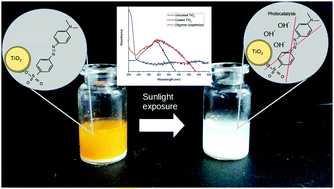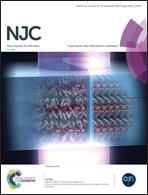Solar light efficient photocatalytic activity degradation of emergent contaminants by coated TiO2 nanoparticles†
Abstract
The photocatalytic degradation of different emergent contaminants in aqueous solutions has been studied by using oligomer-coated TiO2 nanoparticles under solar light irradiation. The oligomer was synthesized using methacrylic acid, ethylene glycol diglycidyl ether and imidazole. The material was characterized by SEM, DLS, FT-IR and FT-Raman and UV-vis spectroscopy. The photocatalytic behavior with the model azo-dye methyl orange was analyzed in different conditions (initial concentration and pH) and the kinetic parameters were described by using the Langmuir–Hinshelwood model. The reuse and photocorrosion of the nanoparticles was studied up to seven operative cycles. The oligomer-coated nanoparticles showed better performance than the uncoated ones due to an increment in absorption in the visible light region. The charge transfer process would form electron/hole pairs (e−/h+) with the holes localized on the organic ligands (most probably on imidazole residues from oligomers) and the electrons in the conduction band of TiO2. Supernatant safety after the photocatalytic treatment was examined by the lettuce seeds assay and no toxicity was found. The versatility of the material was studied by exposing it to different emergent contaminants (ciprofloxacin, trimethoprim and chloramphenicol).



 Please wait while we load your content...
Please wait while we load your content...